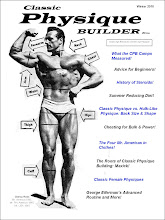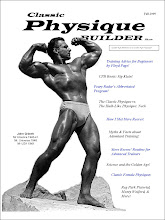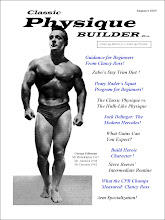
(Photos Above: Steve Reeves - Mr America, Mr World, Mr Universe on the cover of Your Physique magazine Jan 1949 issue; Below: Ronnie Coleman - Mr Olympia)
Another big difference between the classic physique of the Golden Age (the drug and hormone-free 1940s and 50s) and the "Hulk-Like" physique of mainstream bodybuilding is in the waist size. For classic physique builders, the ideal was to have broad shoulders and narrow waist and hips. They placed particular importance on this in achieving their classic symmetry.
For the drug and hormone-using mainstream bodybuilders of today, this ideal is gone. In the quest for sheer, extreme size, the amounts of drugs and hormones taken cause all muscle in the body to get larger - including that of internal organs in the gut. The consequence is "roid gut." As you can tell from the photo of Mr. Olympia (Ronnie Coleman) above, the huge waist is not because of fat. He has more muscular definition (lower body fat) than Steve Reeves. Yet the waist is huge because of the hypertrophic internal body organs (which have smooth muscle which grows in response to drugs and hormones).
In this post, we are focusing on waist size. But there are other differences in abdominal rectus size and shape between classic physique builders and mainstream (drug & hormone using) bodybuilders that we will save for another time.
So looking at Steve Reeves and Ronnie Coleman above, which body would you rather have?
CPB













